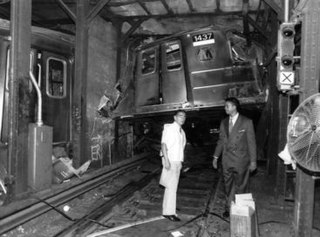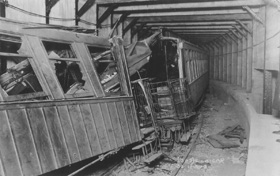
The New York City Subway is a rapid transit system owned by the City of New York and leased to the New York City Transit Authority, a subsidiary agency of the state-run Metropolitan Transportation Authority (MTA). Opened in 1904, the New York City Subway is one of the world's oldest public transit systems, one of the most-used, and the one with the most stations. The New York City Subway is the largest rapid transit system in the world by number of stations, with 472 stations in operation. Stations are located throughout the boroughs of Manhattan, Brooklyn, Queens, and the Bronx.

The Franklin Avenue Shuttle is a New York City Subway shuttle service operating in Brooklyn. The shuttle service uses the BMT Franklin Avenue Line exclusively. The north terminus is Franklin Avenue, with a transfer available to the IND Fulton Street Line. The south terminus is Prospect Park, with a transfer available to the BMT Brighton Line. NYCT Rapid Transit Operations refer to it internally as the S or FS. Like the other two shuttles, the 42nd Street Shuttle in Manhattan and the Rockaway Park Shuttle in Queens, its route bullet is colored dark gray on route signs, station signs, rolling stock, and the official subway map.

The Dual Contracts, also known as the Dual Subway System, were contracts for the construction and/or rehabilitation and operation of rapid transit lines in the City of New York. The contracts were signed on March 19, 1913, by the Interborough Rapid Transit Company and the Brooklyn Rapid Transit Company. As part of the Dual Contracts, the IRT and BRT would build or upgrade several subway lines in New York City, then operate them for 49 years.

The Interborough Rapid Transit Company (IRT) was the private operator of the original underground New York City Subway line that opened in 1904, as well as earlier elevated railways and additional rapid transit lines in New York City. The IRT was purchased by the city in June 1940. The former IRT lines are now the A Division or IRT Division of the Subway.

The Brooklyn Rapid Transit Company (BRT) was a public transit holding company formed in 1896 to acquire and consolidate railway lines in Brooklyn and Queens, New York City, United States. It was a prominent corporation and industry leader using the single-letter symbol B on the New York Stock Exchange. It operated both passenger and freight services on its rail rapid transit, elevated and subway network, making it unique among the 3 companies which built and operated subway lines in New York City. It became insolvent in 1919 and was restructured and released from bankruptcy as the Brooklyn–Manhattan Transit Corporation in 1923.
The IRT Lexington Avenue Line is one of the lines of the A Division of the New York City Subway, stretching from Lower Manhattan north to 125th Street in East Harlem. The line is served by the 4, 5, 6, and <6> trains.

The R Broadway Local is a rapid transit service in the B Division of the New York City Subway. Its route emblem, or "bullet", is colored yellow since it uses the BMT Broadway Line in Manhattan.
The BMT Broadway Line is a rapid transit line of the B Division of the New York City Subway in Manhattan, New York City, United States. As of November 2016, it is served by four services, all colored yellow: the N and Q trains on the express tracks and the R and W trains on the local tracks during weekdays. The line is often referred to as the "N and R", since those were the only services on the line from 1988 to 2001, when the Manhattan Bridge's southern tracks were closed for rebuilding. The Broadway Line was built to give the Brooklyn Rapid Transit Company access to Midtown Manhattan.
The IND Culver Line is a rapid transit line of the B Division of the New York City Subway, extending from Downtown Brooklyn south to Coney Island, Brooklyn, New York City, United States. The local tracks of the Culver Line are served by the F service, as well as the G between Bergen Street and Church Avenue. The express tracks north of Church Avenue are used by the <F> train during rush hours in the peak direction. The peak-direction express track between Ditmas Avenue and Avenue X has not seen regular service since 1987.

The New York City Subway is a rapid transit system that serves four of the five boroughs of New York City, New York: the Bronx, Brooklyn, Manhattan, and Queens. Its operator is the New York City Transit Authority (NYCTA), which is controlled by the Metropolitan Transportation Authority (MTA) of New York. In 2016, an average of 5.66 million passengers used the system daily, making it the busiest rapid transit system in the United States and the seventh busiest in the world.

The N Broadway Express is a rapid transit service in the B Division of the New York City Subway. Its route emblem, or "bullet", is colored yellow, since it uses the BMT Broadway Line in Manhattan.

The BMT Franklin Avenue Line is a rapid transit line of the New York City Subway in Brooklyn, New York, running between Franklin Avenue–Fulton Street and Prospect Park. Service is full-time, and provided by the Franklin Avenue Shuttle. The line serves the neighborhood of Prospect Heights, and allows for easy connections between the Fulton Street Line and the Brighton Line.

The Brooklyn City Railroad (BCRR) was the oldest and one of the largest operators of streetcars in the City of Brooklyn, New York, continuing in that role when Brooklyn became a borough of New York City in 1898.

57th Street–Seventh Avenue is an express station on the BMT Broadway Line of the New York City Subway. Located in Midtown Manhattan at the intersection of 57th Street and Seventh Avenue, it is served by the N and Q trains at all times, the R train at all times except late nights, and the W train on weekdays.

Prospect Park is an express station on the BMT Brighton Line of the New York City Subway. Located at Empire Boulevard and Flatbush Avenue in Flatbush, Brooklyn, near the border of Crown Heights, Prospect Heights, Park Slope, and Prospect Lefferts Gardens, it is served by the Q train and Franklin Avenue Shuttle at all times and by the B train on weekdays.

The D-Type, commonly known as the Triplex, was a New York City Subway car class with four units built as a prototype in 1925 and the production units built during 1927 and 1928. They were built by the Pressed Steel Car Company.

28th Street is a local station on the BMT Broadway Line of the New York City Subway, located at 28th Street and Broadway in Manhattan. It is served by the R train at all times except late nights, the W train on weekdays, the N train during late nights and weekends and the Q train during late nights.
The New York City Subway's B Division consists of the lines that operate with lettered services, as well as the Franklin Avenue and Rockaway Park Shuttles. These lines and services were operated by the Brooklyn–Manhattan Transit Corporation (BMT) and city-owned Independent Subway System (IND) before the 1940 city takeover of the BMT. B Division rolling stock is wider, longer, and heavier than those of the A Division, measuring 10 or 9.75 ft by 60 or 75 ft.
During the evening rush hour on August 24, 1928, an express subway train derailed immediately after leaving the Times Square station on the IRT Broadway–Seventh Avenue Line. Sixteen people were killed at the scene, two died later, and about 100 were injured. It remains the second-deadliest accident on the New York City Subway system, after the Malbone Street Wreck.

The 1991 Union Square derailment occurred shortly after midnight on August 28, 1991, a 4 Lexington Avenue Express train on the New York City Subway's IRT Lexington Avenue Line derailed as it was about to enter 14th Street–Union Square, killing five people. It was the worst accident on the subway system since the 1928 Times Square derailment. The motorman was found at fault for intoxication and excessive speed, and served time in prison for manslaughter.

















